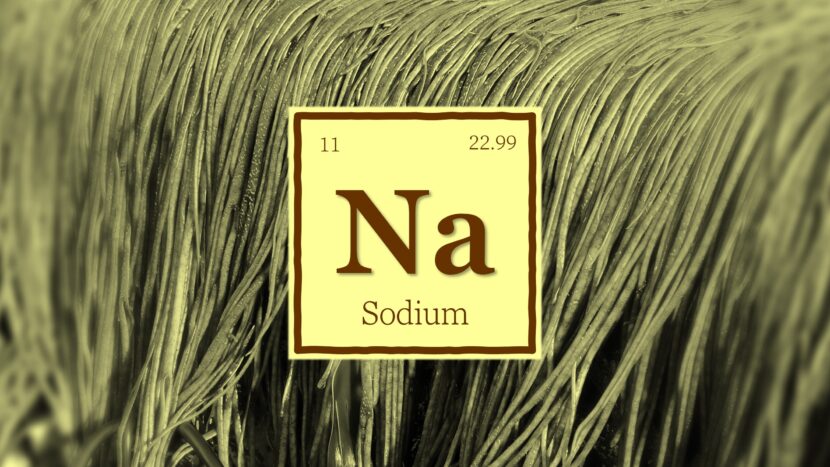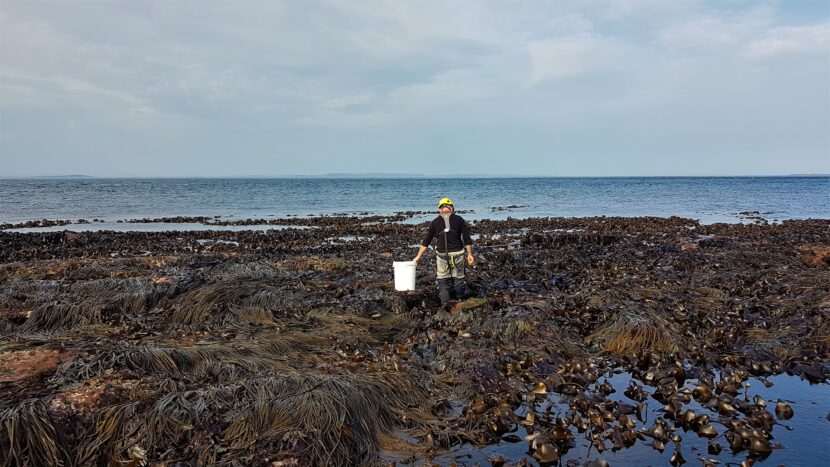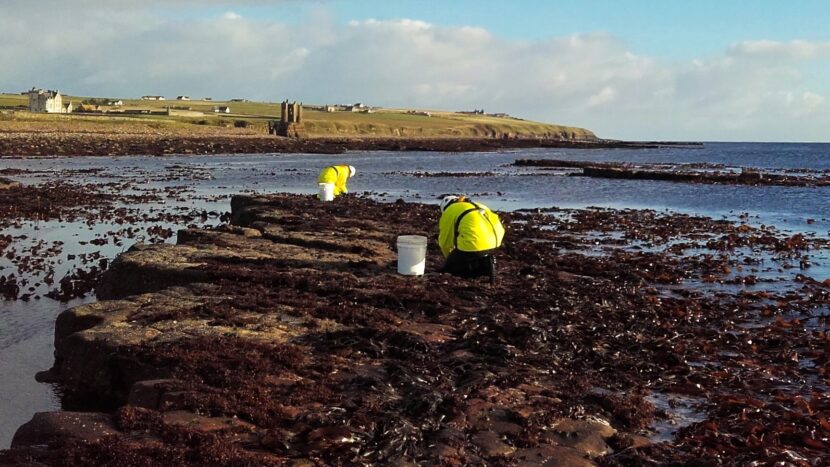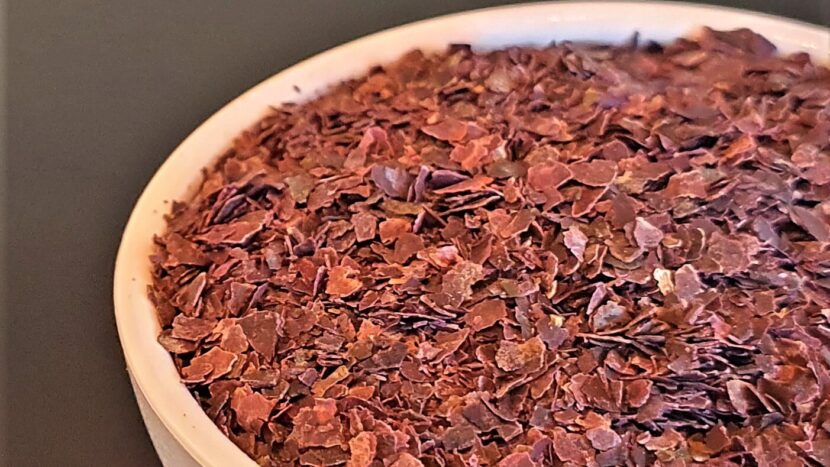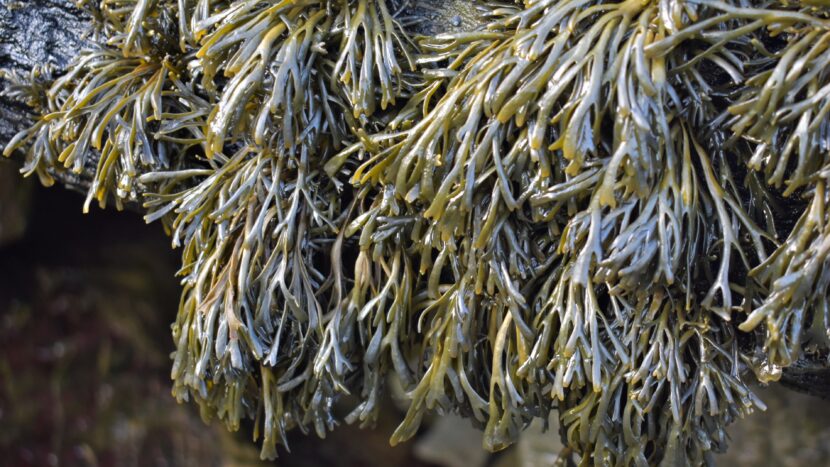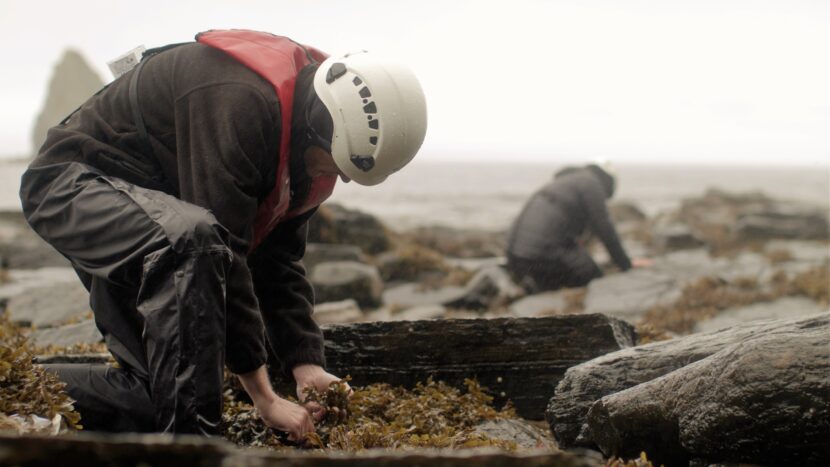Our coast: Ness of Duncansby

In the first of a series of posts focusing on our harvest sites around Caithness, Peter Elbourne shares some thoughts about the coastline at the Ness of Duncansby. Lying a short distance east of John O’Groats, the site is uniquely positioned at the corner of the most northerly county in Britian. A range of seaweed species can be found there, but the idiosyncratic tides mean care must be taken when harvesting. There are also extraordinary carvings of Chilean poetry to be discovered at low water. Intrigued? Read on to learn more.

View west from our Ness of Duncansby harvest site at sunset
A rocky headland in the corner of Scotland
Our Ness of Duncansby site is two kilometres of rocky shore between John O’Groats and the Bay of Sannick, around 25 minutes’ drive from our factory in Wick. The name Ness of Duncansby is Norse in origin – like most placenames in Caithness – and simply means the headland at Duncan’s farm. It marks the eastern edge of the Pentland Firth, where the North Atlantic meets the North Sea. Currents squeeze in between the mainland and the southern extent of the Orkney archipelago. Huge tidal movements create standing waves known as the Boars of Duncansby. Sailors have always passed through these waters with great care, especially as gales tend to amplify the height of the tidally driven waves.
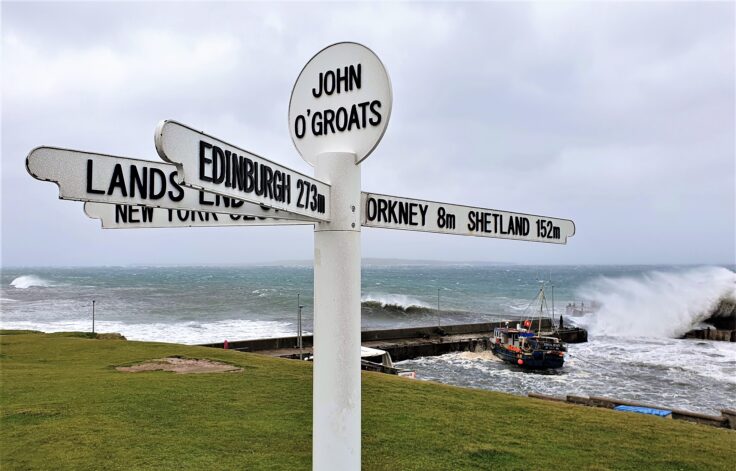
The famous northerly village of John O’Groats is a short walk from our harvest site
Duncansby Head rises above the Bay of Sannick, offering striking views of our harvest site and Orkney beyond. A short walk south from the lighthouse is rewarded with a view of the iconic Stacks of Duncansby: a must-see for anyone touring the North Coast 500. There is no shortage of birdlife in the area. Puffins, fulmars and razorbills nest on the cliffs to the east at Duncansby Head, which is a protected Site of Special Scientific Interest. Indeed, the conservation area runs from the edge of our Ness of Duncansby site south to the edge of our site by the village of Skirza. In addition to resident seals, porpoises and dolphins, there is the chance of spotting orca and minke whales navigating their way through the Pentland Firth. Long summer days give the best chance of success, both for calmer seas and the abundance of seasonal visitors.
We also know that this area was once home to other creatures. Fossilised fish are well preserved in the John O’Groats sandstone group. Several species of prehistoric fish were first identified here, including the lobe-finned lungfish Pentlandia macroptera that eventually evolved into four-legged air-breathing animals and the tiny armoured fish Microbrachius dicki that was the first vertebrate to show evidence of internal fertilisation (that translates as sex to non-scientists!). A patch of foreshore about the size of a football pitch next to John O’Groats harbour - a short distance away from the western extent of our licenced harvest area - is designated a Site of Special Scientific Interest to recognise its importance for paleontology.
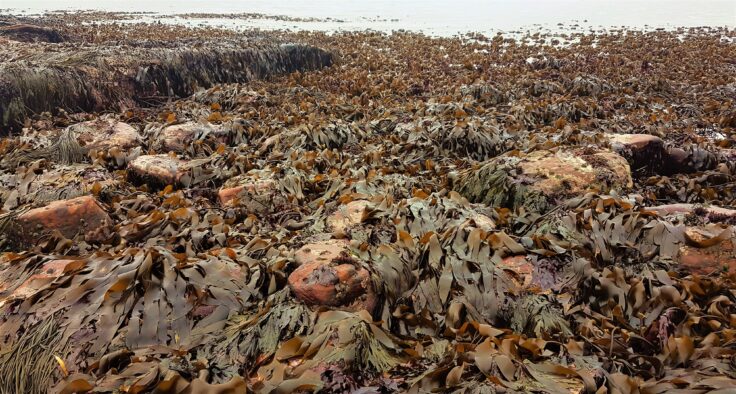
Low tide at Ness of Duncansby reveals an array of seaweed species
Bringing the harvest site into licence
We first surveyed the shores around Caithness in March 2014, with expectation that the coastline by John O’Groats would be a good place to harvest seaweed. On-the-ground inspection proved this to be the case. We applied scoring around accessibility, exposure and varieties of seaweed to help prioritise which sites to take forward for harvest licencing. Ness of Duncansby scored highly, ranking in the top five stretches of foreshore in Caithness. Following biomass surveys, in 2016 it became one of our first harvest sites licenced with Crown Estate Scotland.

Our harvest site at Ness of Duncansby in the far north of Scotland
Credit: Contains Ordnance Survey data, Crown copyright and database right 2014One of the attractions of Ness of Duncansby was the relatively easy access down to the shore, although there are gullies and bouldery sections that are harder to navigate. Much of the rocky shore in Caithness is made up of slate flagstones, but Ness of Duncansby is mostly Devonian old red sandstone. At the eastern edge of the site lies the beautiful Bay of Sannick: a quiet stretch of white shell sand beneath verdant grassy slopes. It is one of the most northerly sandy beaches on the British mainland and is known by beachcombers as a great spot to pick up cowrie shells. Called groatie buckies locally, they are supposed to bring good luck - never go anywhere without a cowrie shell!
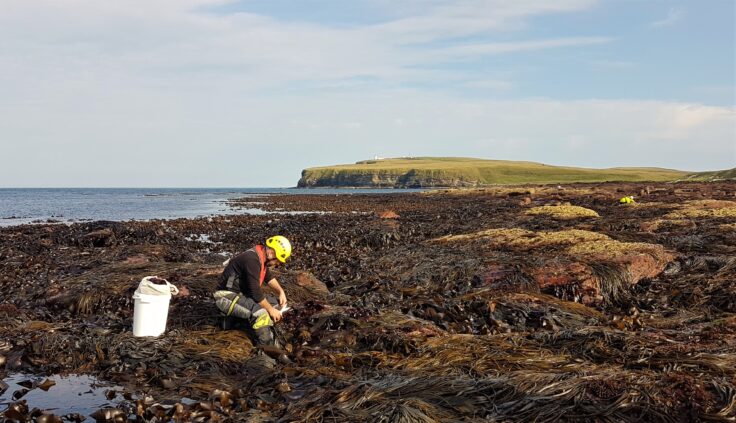
Harvester cutting seaweed by hand at low tide, with Duncansby Head in the background
Harvesting around unusual tides
One of the challenges at Ness of Duncansby is working with quirky tides. The nearest tidal gauge is at Gills Bay around 6km to the west. Normally, there would be little difference in the time of low water between two points so close together. However, various online tidal projections state low water is over one hour later at Ness of Duncansby than Gills Bay. This is due to the tidal races in the Pentland Firth. Unfortunately, it makes it difficult to time visits precisely around low tide: we have had to hastily complete our surveys on several occasions!
The high water exchange brought by the strong tides means that there is a broad diversity of seaweed species, especially on the low shore. While there are good amounts of sea spaghetti, bladder wrack, toothed wrack and kelp, our 46 visits to date have focused on harvesting dulse and knotted wrack. Other sites are better for dulse, but we can carefully plan our harvests to take advantage of the unique tidal regime at Ness of Duncansby.
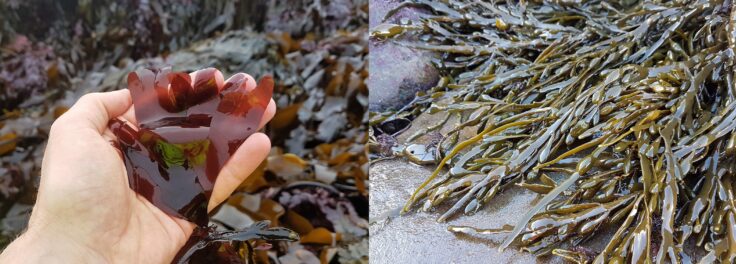
Two important species of seaweed at Ness of Duncansby: Dulse (Palmaria palmata) and Knotted wrack (Ascophyllum nodosum)
Mysterious carvings of Chilean poetry
I will never forget the day we stumbled across something extraordinary at Ness of Duncansby. Our discovery was not during our first visit in 2014, but probably the following summer when we carried out more detailed biomass surveys. While waiting for low tide, we walked across the mid-shore and noticed letters carved into the sandstone. Remarkably, they formed Spanish words. This floored my fellow surveyor as she was a marine biologist from Spain: imagine walking through the sea mist at the edge of a foreign country and finding carvings of words in your native language!
We did some research after the survey and found an article on BBC News from 2013, which seems to be when the carvings were first encountered. The words are from a sonnet written by Chilean poet and diplomat Pablo Neruda, written soon before he died. It is possible that the entirety of the Las Pedrias del Cielo – Stones of the Sky – has been etched into sandstone, but it is difficult to trace all the words. Stones often feature in Neruda’s work, representing permanence and foundation, although the title here is meant to indicate heavenly, spritual stones. There is now a sign in the car park at John o’Groats with the Spanish text and English translation – there is even a sung performance available on YouTube.

Stunning carvings of poetry by Pablo Neruda are only revealed at low tide
Incredibly, the artist who created this work seemingly remains unknown. Further carvings of Neruda poetry were discovered nearby in 2022, likely created after the original inscriptions. This time, some Greek letters were also found that suggest the artist may be someone named Stefanos. The words are elegantly marked in the rock and so would have taken many low tides to complete, especially if trying to avoid detection. The details of the thousands of characters will be lost to erosion over time. Barnacles selectively choose crevices over smooth surfaces, growing to an extent where many letters are now filled with white shells. No doubt the artist was conscious of the symbolism of these natural processes of change.
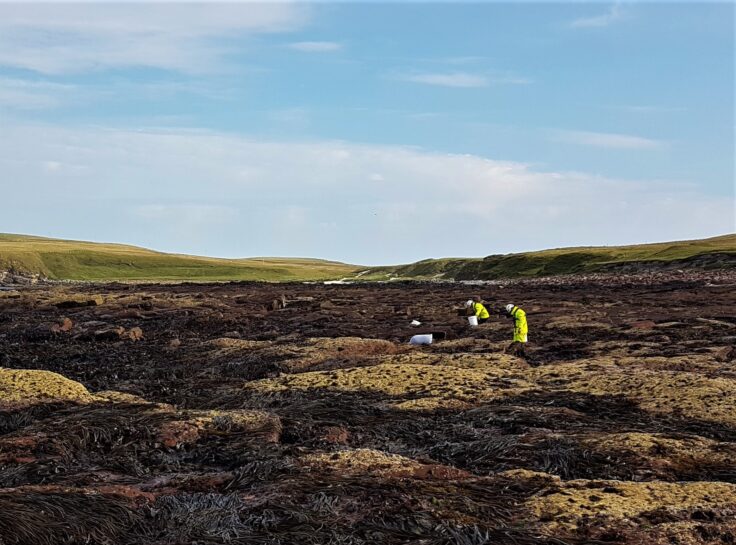
The Horizon Seaweed team harvesting on the mid-shore at Ness of Duncansby
A beautiful place to visit
We highly recommend spending a little time on the coastline here if visiting John O'Groats. Check out duncansby.me, which has stunning photographs of the landscapes and wildlife in the area. If you want to try and hunt out the Pablo Neruda carvings, they are on the rocks close to the transition to the sandy beach at Bay of Sannick (approximately 58.646, -3.044). You will need to go down onto the shore within an hour or two of low water on a spring tide. Be patient, because the carvings are dispersed over a wide area and we have struggled to find them on some visits. Make sure you have sturdy footwear, but no doubt you’ll be prepared with the right gear if touring Caithness!
Hopefully you have found this focus on our harvest site at Ness of Duncansby interesting. Provenance is crucial to many applications for seaweed, especially food and drink. People care about where their ingredients come from. Look out for more posts sharing stories of other stretches of coastline where we harvest.
